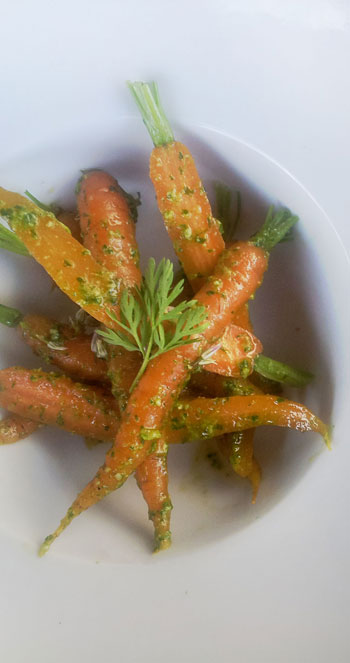30 Vintage Recipes of Delicious Dairy Delights
Wisconsin dairy farmers share their home-cooked recipes. Find crumb cake, cream cake, strawberry punch, and more from America’s Dairyland, circa 1949.

Dairy Foods Calendar
Originally published in The Country Gentleman, June 1, 1949
June is National Dairy Month. These recipes featuring milk and milk products come from dairy-farm homemakers in Wisconsin and give you 29 good ways to serve your family nature’s best food.
1. Cottage Cheese Jam Tarts
(Makes about 2 dozen)
Sift together 1 cup of sifted flour and 1/4 teaspoon of salt. Cut in 1/3 cup of shortening until the mixture is the texture of coarse meal. Add 1/2 cup of cottage cheese, and work into a smooth ball. Chill 1/2 hour, or until firm. Roll out on a floured pastry cloth 1/8 inch thick. Cut in 3-inch squares. Place a teaspoon of cranberry sauce, or fruit marmalade, in center of each square. Fold over and pinch edges together. Bake on ungreased baking sheet in a hot oven (425° F) 10 minutes, or until lightly browned.
2. Uncooked Salad Dressing
(Makes 1 quart)
With a rotary beater or electric mixer, beat together 2 beaten eggs, one 15-ounce can of sweetened condensed milk, 1/2 cup of melted butter, 1/2 teaspoon of salt, 1/2 teaspoon of pepper, and 1 cup of vinegar. Store in a quart jar in the refrigerator. Thickens overnight and keeps well.
21st-century tip: Sub in coddled (gently cooked) eggs for raw ones.
3. Beets in Sour Sauce
(Serves 4 to 6.)
Add 2 tablespoons of flour to 1 cup of thick sour cream. Cook in top of double boiler until thickened, stirring constantly. Add 1 tablespoon of prepared horseradish, 1 teaspoon of vinegar. Salt and pepper to taste. Add 3 cups of sliced, cooked beets, drained. Reheat, stirring occasionally.
4. Bunnies
Trim the crusts from sliced bread. Spread with butter and nippy spreading cheese. Roll up as for jelly roll, wrap each roll with a slice of bacon, and fasten with toothpicks. Broil in oven or over an outdoor fire. Good for Saturday-night supper, picnic style.
5. Butter Crunch
Melt 4 tablespoons of butter in a heavy saucepan. Stir in 1 cup of brown sugar and 2 tablespoons of flour. Add 1/4 cup of water. Cook over low heat until a drop of the mixture forms a soft ball in cold water (236° F). Quickly pour mixture over 4 cups of corn flakes, mixing thoroughly until well coated. Spread out on large pan to cool. Form into balls and chill. Serve in place of cake or cookies with ice cream.
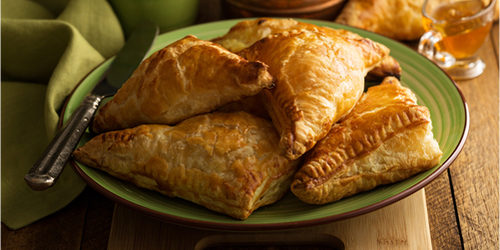
6. Ham-Cheese Turnovers
(Makes 9 turnovers)
Combine 1 1/2 cups of ground cooked ham, 2 tablespoons of finely chopped dill pickle, 1 teaspoon of dry mustard, 1 teaspoon of onion juice, and 1/4 cup of mayonnaise. Sift together 2 cups of sifted flour, 3 teaspoons of baking powder, and 3/4 teaspoon of salt. Cut in 5 tablespoons of shortening. Add 2/3 cup of milk and mix to a soft dough. Turn out on a floured board and roll 1/4 inch thick. Cut into nine 4-inch squares. Brush with melted butter. Place a triangle of thinly sliced cheddar cheese on half of each square. Top with a spoonful of the ham mixture. Fold dough over to form a triangle, and press edges together. Bake on a greased baking sheet in a hot oven (425° F) 25 minutes. Serve hot or cold.
7. Frozen Pineapple Salad
(Serves 6)
Set temperature control on refrigerator at lowest point. Combine 2 cups of thick sour cream with 1 tablespoon of lemon juice and 3/4 cup of sugar. Fold in 1 cup of drained, sweetened, crushed pineapple and 1/4 cup maraschino cherries. Pour into freezing tray of refrigerator and freeze until firm. Cut into squares and serve on lettuce or other greens.
8. Butterscotch Squares
(Makes about 1 dozen squares)
Cook 1/2 cup of butter and 2 cups of brown sugar over low heat until bubbly around edges. Cool. Add 2 eggs, beating well after each addition. Add 1 teaspoon of vanilla and 2 cups of sifted flour, sifted together with 1/4 teaspoon of salt and 2 teaspoons of baking powder. Stir in 1 cup of dry, shredded coconut and 1 cup of chopped nuts. Spread in a greased shallow pan (10 1/2 by 15 inches), and bake in a moderate oven (350° F) 25 minutes.
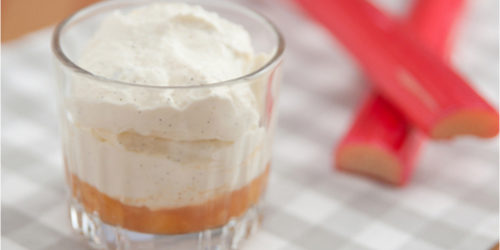
9. Rhubarb Cream Mousse
(Makes 4 to 6 servings)
Set cold control of refrigerator to coldest point. Mix together 1 cup of mashed, cooked rhubarb and 1/2 cup of sugar. Cool thoroughly and add 1 teaspoon of lemon juice. Fold in 1 cup of heavy cream, whipped. Pour into freezing tray. Freeze until firm (2 to 4 hours). Serve with topping of sweetened whipped cream.
10. Cheese Ring
(Serves 6)
Mix together 3 cups of cooked noodles, 1 cup of grated sharp cheese, 4 beaten eggs, 3/4 cup of milk, 2 tablespoons of tomato catsup, 1 tablespoon of Worcestershire sauce, and salt and pepper to taste. Pour into a well-buttered and floured ring mold. Set in a pan of hot water and bake in a moderate oven (350° F) 40 minutes, or until firm. Unmold on a hot platter; fill center with buttered June peas or creamed mixed vegetables. Garnish with deviled eggs around the ring.
11. Gingerbread with Cheese Filling
Combine 1 cup of cream cheese, 1 cup of chopped dates, 1 cup of chopped nuts, and 1/2 teaspoon of salt. Add enough cream to make mixture of a spreading consistency. Split open hot gingerbread. Spread cheese filling between layers. Serve at once.
12. Dairyman’s Delight
(Makes 6 servings)
Stew a 4-to-5-pound hen until tender (2 to 3 hours). Cut meat from bones, cube, and brown in butter. Add 1/2 pound of cooked noodles, 1/2 of a large green pepper, chopped, 1/3 cup of chopped pimiento, and 1 cup of cooked whole-kernel corn. Stir in 1 cup of chicken broth. Add salt and pepper to taste. Turn into a buttered baking dish, and cover with 1/2 pound of sharp cheese, cut in cubes. Bake in a moderate oven (350° F) 30 minutes.
13. French-fried Cheese Sandwiches
(Makes 4 sandwiches)
Spread 8 slices of white or whole-wheat bread with butter. Lay slices of American cheese on half the slices of bread. Press on top slices, and cut sandwiches in half. Beat 2 eggs, 1/4 cup of milk, and 1/4 teaspoon of salt together until well-blended. Dip sandwiches in egg-milk mixture and fry slowly in butter until golden-brown, and cheese is melted.

14. Peppermint-Marshmallow Ice Cream
(Makes 1 quart)
Set temperature control on refrigerator to coldest point. Scald 1 cup of milk. Add 14 marshmallows and stir until dissolved. Cool. When cold, stir in 1/8 teaspoon of salt, 1/2 teaspoon of vanilla, 1/2 cup of finely crushed peppermint-stick candy, and 1 cup of heavy cream, whipped. Add a few drops of red food coloring to give a delicate pink color. Blend coloring carefully.
Pour into freezing tray. When partially frozen (about 1 1/2 hours) return mixture to bowl. Beat with rotary beater until creamy. Return to refrigerator and freeze until firm. Ground sweet chocolate may be used in place of peppermint for chocolate ice cream.
15. Buttermilk Cupcakes
(Makes 12 large cupcakes)
Cream together 1 tablespoon of butter and 1 cup of sugar. Add 1 beaten egg and 1/2 teaspoon of lemon flavoring. Blend thoroughly. Sift together 1 1/2 cups of sifted cake flour and 1/2 teaspoon of soda. Add to egg mixture alternately with 1 cup of buttermilk, stirring just enough to blend after each addition. Pour into greased cupcake pans and bake in a moderately hot oven (375° F) 25 minutes.
16. Cheese-Stuffed Potatoes
(Serves 4)
Bake 2 large potatoes in a moderately hot oven (375° F) 1 to 1 1/2 hours, or until done. Cut in half, lengthwise. Scoop out insides and mash with milk. Add 1 cup of cottage cheese, 1 tablespoon of chopped chives, 1 1/2 tablespoons of melted butter, 1/8 teaspoon of pepper, and 1 teaspoon of salt. Beat until light and fluffy. Fill potato shells with mixture. Dot with extra butter and sprinkle with paprika. Bake in a moderately hot oven (375° F) 15 to 20 minutes, or until lightly browned and thoroughly heated.
17. Scalloped Salmon
(Makes 4 to 6 servings)
Drain and flake one 1-pound can of salmon. Reserve liquid. Fry 2 cups of 4-inch bread cubes in 2 tablespoons of butter, stirring constantly until evenly browned. Remove from pan and spread half of the cubes in the bottom of a buttered, shallow baking dish. Cover with salmon. Melt 2 more tablespoons of butter and stir in 2 tablespoons of flour. Add 1 1/4 cups of milk. Cook over low heat until thickened, stirring constantly. Stir in salmon liquid. Add 1/4 teaspoon of salt and 1/3 teaspoon of pepper. Pour over salmon and cover with remaining bread cubes. Bake in a moderately hot oven (375°F) 25 minutes.
18. Refrigerator Butter Rolls
(Makes 2 to 3 dozen rolls)
Combine 1 cup of scalded milk, 1/2 cup of butter, 1/4 cup of sugar, and 1/2 teaspoon of salt. Cool to lukewarm. Add 1 cake of yeast, crumbled fine, and 2 beaten eggs. Add 2 cups of sifted flour and beat well. Blend in 2 more cups of sifted flour. Cover and chill in refrigerator several hours, or overnight.
Roll out on a floured board to 1/3-inch thickness. Cut with a 2-inch biscuit cutter and brush with melted butter. Fold each roll in half Aid place on a greased baking sheet. Cover lightly and let rise in a warm place until doubled in bulk. Brush with melted butter. Bake in a hot oven (425°F) 10 to 15 minutes. (This dough will keep in the refrigerator for several days and may be used for coffee cake, sweet rolls, or tea rings.)
19. Sour Cream Potato Soup
(Makes 6 servings)
Cook 3 cups of diced potatoes, 1/2 cup of chopped celery, and 2 tablespoons of chopped onion in a small amount of boiling, salted water until just tender. Do not drain. Press through a sieve. Heat 3 cups of milk in double boiler until warm. Add 3 tablespoons of butter and the sieved potatoes. Mix 1 cup of thick sour cream with 1 tablespoon of flour until smooth. Add to soup. Add salt and pepper to taste. Cook until thickened, stirring constantly.
20. Lettuce with Sour Cream Dressing
(Serves 4 to 6)
Mash yolks of 3 hard-cooked eggs. Add 1/2 teaspoon of sugar, 1/8 teaspoon of pepper, 1 cup of sour cream, and 1 teaspoon of vinegar. Mix thoroughly. Makes about 1 cup of dressing.
To serve, tear a medium head of lettuce into small pieces. Sprinkle with salt and mix with desired amount of dressing. Garnish with finely chopped hard-cooked egg.

21. Eddie’s Ice Cream
(Makes 2 quarts)
Set temperature control of refrigerator at lowest point. Scald 2 2/3 cups of milk. Combine with 1 1/3 cups of sugar, 1 1/3 tablespoons of flour, and 2 beaten eggs. Mix well and cook in the top of a double boiler 20 minutes, or until mixture coats a spoon. Cool. Add 2 2/3 cups of light cream and 1 tablespoon of vanilla. Pour into 2 freezing trays. Freeze until mushy, about 1 hour. Turn ice cream into a large bowl and beat with rotary beater until smooth. Return to refrigerator until firm.
22. Buttermilk Biscuits
(Makes 2 to 3 dozen biscuits)
Sift together 4 cups of sifted flour, 4 teaspoons of baking powder, 1 teaspoon of salt, and 1/2 teaspoon of soda. Cut in 1 cup of shortening until the consistency of coarse meal. Add 2 cups of fresh buttermilk, and mix well. Turn out on a floured board and knead until smooth and easy to handle. Roll out to 3/4-inch thickness. Cut with biscuit cutter and bake on an ungreased baking sheet in a hot oven (425° F) 20 minutes, or until golden brown.
23. Chocolate Sundae Sauce
(Makes about 1 cup of sauce)
In top of double boiler melt 1/4 cup of butter and 1 square of bitter chocolate. Stir in 1 cup of sugar, 3/4 cup of cocoa, 1/8 teaspoon of salt, and 3/4 cup of light cream. Cook over hot water until smooth, stirring occasionally. Remove from heat and add 1 teaspoon of vanilla. Serve warm over ice cream.
24. Spoonbread
(Makes 8 servings)
Stir 1 cup of corn meal into 2 cups of milk, and cook over low heat until a mush is formed. Cool. Add 3 well-beaten eggs, 2 tablespoons of butter, 1 teaspoon of salt, and 1 cup of milk. Beat well and turn into a buttered baking dish. Bake in a moderate oven (350°F) 40 minutes, or until well-browned. Serve from baking dish while hot. Use butter liberally.
25. Chocolate-Chip Pie
Combine 12 finely crushed graham crackers, 2 1/2 tablespoons of melted butter, and 1 1/2 teaspoons of sugar. Press into the bottom and sides of an 8-inch pie pan. Bake in a moderately hot oven (375° F) 5 minutes.
Heat 1/2 cup of milk. Add 15 marshmallows and stir until dissolved. Cool. When cold, fold in 1 cup of heavy cream, whipped, and one 2-ounce square of unsweetened chocolate, shaved fine. Pour into cooled crust and chill until firm. Makes one 8-inch pie.
26. Breakfast Crumb Cake
(Makes 8 servings)
Sift together 2 cups of sifted flour, 1 teaspoon of salt, 1/4 teaspoon of soda, 2 1/2 teaspoons of baking powder, and 1/3 cup of sugar. Cut in 1/3 cup of butter until consistency of coarse meal. Add 1 slightly beaten egg to 1/3 cup of buttermilk. Combine quickly with dry ingredients. Spread in a 9-inch square buttered cake pan and cover with crumb topping.
To make topping, combine 1/2 cup of brown sugar, 2 tablespoons of flour and 1 1/4 teaspoons of cinnamon. Cut in 2 tablespoons of butter. Bake in hot oven (400° F) 25 to 30 minutes.
27. Veal and Peas in Cream
(Makes 6 servings)
Brown 1 1/2 pounds of cubed veal steak and 1 chopped onion in 3 tablespoons of butter in a heavy skillet. Add 1 can of cream of mushroom soup, 1 cup of light cream, and 1 cup of milk. Cover and simmer until tender (45 minutes to 1 hour), stirring occasionally. Add 1 cup of cooked peas and salt and pepper to taste. Cook 2 to 3 minutes longer. Serve over noodles or mashed potatoes.
28. Eggnog Pie
(Makes one 9-inch pie)
Heat 1 cup of rich milk and 1/2 teaspoon of nutmeg in the top of a double boiler. Beat together 3 egg yolks, 1/2 cup of sugar, and 1/8 teaspoon of salt. Add to milk and cook, stirring constantly until mixture coats the spoon. Soak 1 tablespoon of gelatin in 1/4 cup of cold water and add to custard. Let cool. Add 1/2 cup of shredded coconut and 1 teaspoon of vanilla. Fold in the 3 stiffly-beaten egg whites. Pour into a 9-inch graham cracker crust, chill, and top with 1/2 cup of cream, whipped. Sprinkle with grated semisweet chocolate.
21st-century tip: Sub meringue powder for egg whites.
29. Sour Cream Cake
Cream together 1/2 cup of butter and 2 cups of brown sugar. Add the yolks of 3 eggs, and beat. Sift together 2 cups of sifted cake flour, 1/4 teaspoon of salt, 1 teaspoon of cloves, 1 teaspoon of allspice, 1 teaspoon of cinnamon, 1/2 teaspoon of baking powder, and 1/2 teaspoon of soda. Add to creamed mixture alternately with 1 cup of sour cream. Fold in the 3 stiffly-beaten egg whites. Bake in a greased loaf pan in a moderate oven (350°F) 45 to 50 minutes.

30. Strawberry Punch
(Makes 4 servings)
Clean and sieve 2 cups of strawberries. Mix in 1/3 cup of sugar. Chill. Add 2 cups of milk and 1/2 pint of strawberry ice cream, stirring until the ice cream is partially melted. Pour into glasses. Garnish with whole berries.
10 Savory Herbs to Add to Your Garden This Spring
Tips from 1943 for growing 10 fresh herbs — and how to use them.
—
10 Savory Herbs Grow in My Garden
Originally published in The Country Gentleman, March 1, 1943
Cooking would be less of an adventure without my “yarb patch” and its 10 savory herbs I’ve found most satisfactory. Your own choice, after experiment, may not coincide exactly with mine, but you’ll find herbs are not hard to raise. They thrive on average to poor soil; many are drought-resistant and most of them are pest and disease resistant. They will need at least six hours of sun a day and many do best in full sun. Many can be grown from seed, but all may be purchased as started plants from reliable nurseries.
From one to three plants of any herb will be enough for the average family, except perhaps dill and caraway.
PARSLEY, of course, comes first. It’s a biennial, but since it is not a hardy one in my climate — Iowa — I sow fresh seed every year. In the fall I transfer a plant or two to 6-inch pots in a sandy soil mixture and cut them back rather severely. They prefer a sunny south window in a cool room and, watered well, supply all the fresh parsley our family can use.

Good hashed brown potatoes are even better with 1/2 cup of chopped parsley for 6 servings. It adds color and flavor to buttered whole carrots and may be used generously in stews and vegetable soup. Sprinkled on top of potato or bean soup, it’s good to look at and better to taste.
CHIVES may be started from seed, but bunches or pots of chives are not expensive and can be divided into many little plants. Three or four bulblets should be set together, the groups spaced 7 or 8 inches apart. The plants mingle well with other perennials in the flowerbed where their fluffy lavender blooms are interesting in spring and the slender leaves make a green clump until frost.
The chopped-up leaves lend a whisper of onion flavor that blends well with other seasonings. Men will like chives even better than parsley with buttered new potatoes. Chives give a lift to fried potatoes, cottage cheese, vegetable salads, scrambled eggs, and omelettes. Chive butter is made and used the same way as parsley butter.
SAGE is a pretty perennial, growing three or four feet high, with gray-green pebbled leaves which remain fresh until a hard frost. Each plant needs about 2 square feet of space. Sage is almost a must for pork sausage and poultry stuffing. I use 1/2 teaspoon of dried leaves for 1 pound of ground pork and 1 teaspoon for 2 cups of soft bread crumbs. Also, my family likes sage tea made by mixing1/4 teaspoon of sage with hot milk.
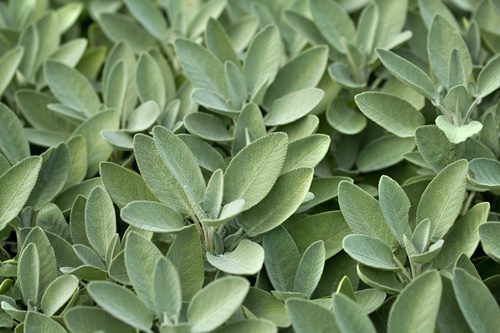
THYME is a dainty-leaved little perennial growing 8 to 10 inches high. It seems to have an affinity for meats and meat dishes, so we sprinkle a little — say a tablespoon — of fresh leaves or a teaspoon of dried leaves over a 4- or 5-pound pork roast. Or we roll “pencils” of salt pork in dried thyme, salt and pepper and insert them, with a little onion, in slashes made every 2 to 3 inches in veal or pot roast. Creamed chicken is special with 1/4 teaspoon of dried thyme added to 6 servings. The same amount improves creamed chipped beef. A pound of ground beef with 1/4 teaspoon of dried thyme makes delicious hamburgers. Grape jelly flavored with thyme is a pleasing accompaniment for any kind of meat.
SWEET MARJORAM is really a perennial but not very hardy in cold climates, so I raise it in the garden in the summer and bring some of the small plants which have not yet bloomed into the house for my winter herb garden. It grows about 12 to 15 inches high and needs about that much space between plants.
Marjoram, like thyme, is an important addition to meat loaf and hamburgers, using 1/2 teaspoon of the dried herb or 1 tablespoon of fresh for 2 pounds of meat. Try a roast of lamb with a dozen whole cloves stuck in the top of the raw meat and a mixture of 3 tablespoons of brown sugar and 1 tablespoon of sweet marjoram sprinkled over the top. Bake at 300° F. One finely snipped marjoram leaf to each egg makes a new scrambled-egg dish and 1/4 teaspoon of minced marjoram may be added to a quart of vegetable soup with delightful results.

BASIL is an annual growing 12 to 15 inches high. It has many uses in soups, stews, and salads, but I like it best with tomatoes. One leaf or a part of one, according to your tastes, added to a quart of freshly stewed tomatoes or a combination of half tomatoes and half okra makes a dish fit for a king. Dried basil adds an important touch to many herb mixtures to be used as bouquets in little bags or mixed directly with the food during the cooking process. Basil has such a pleasant, spicy odor that I grow some in a box on the back porch so I can take a sniff every time I step out.
MINT is a whole family — spearmint, peppermint, apple mint, and orange mint; all are perennial, growing about 18 inches high. The mint leaf floating on a glass of lemonade and the mint sauce or jelly companion for lamb are well known, but did you ever eat minted peas or carrots or potatoes? Chop the fresh leaves very fine and sprinkle as little or as much as you like on the buttered vegetable. Candied mint leaves, glistening and sweet smelling, are a delightful confection. Wash and dry fresh mint leaves. Hold the stem in one hand while “painting” on both sides with egg white mixed with a little water; use a small, pencil-sized brush. Using a shaker, sprinkle with granulated sugar on both sides and lay on wax paper to dry.
DILL is fairly common in many gardens, where it generously produces seed to add zest to a wide variety of cucumber pickles. It’s a pity if you’ve never tasted sweet dills. This is the way I make them: Pack in an earthen jar alternate layers of washed grape and cherry leaves, heads of dill, and medium-sized cucumbers. Cover well with a brine made with 1 cup of salt to 5 quarts of water. Let stand two weeks and drain. Cut cucumbers in 1-inch pieces and pack in jars. For each quart make a sirup with 1 cup of vinegar, 2 cups of sugar, and 2 tablespoons of whole allspice. Pour boiling hot over cucumbers, and seal.
Dill seeds, about 1/2 teaspoon to 6 servings, are a nice addition to Harvard beets, and some folks sprinkle 10 or a dozen dill seeds over the apples in a pie. One tablespoon of fresh new dill leaves chopped very fine does something definite for a quart of potato salad, and 1 teaspoon of dill seeds to a quart of sauerkraut makes a “special” for our family.

Dill is a self-sowing annual growing about 3 feet tall. It dies after the seeds are ripe, so it is best planted at the back of the garden where it can be cut down.
SUMMER SAVORY is another herb used more often in combination with other herbs than alone. It is especially good with beans, either fresh or dried. One half teaspoon of dried summer savory — or 1 tablespoon of fresh — added to 1 quart of fresh or canned string beans is a nice change from plain beans. The same amount adds a new flavor to a quart of lima beans or to our good old friend, bean soup.
Summer savory is a slender, graceful annual about 15 inches high. Plants should be 6 inches apart.
CARAWAY is the last of my list of kitchen herbs and I grow it for its flavorsome seeds. If you have never eaten caraway cookies, it is time you did. Just add 2 or 3 teaspoons of caraway seeds to your favorite lemon-flavored sugar-cooky dough and there you are! Braised cabbage, particularly red cabbage, with caraway seed is really good. For 1 pound of shredded cabbage, melt 2 tablespoons of butter, add 1/4 cup of brown sugar, 1/3 cup of vinegar, 1/2 teaspoon of caraway seed and finally the cabbage. Cook about 20 minutes, stirring often. Caraway seeds are sometimes added to rye bread and sauerkraut and they are not bad as a “munch” after meals. Beets are unusual and good if they have stood 1 hour in a hot marinade of 1 cup of vinegar, 1/3 cup of water, and 1 teaspoon of caraway seed.
Caraway is a biennial, so blooms and produces seeds the second year. Like dill, it self-sows, so after the first planting there will always be caraway plants in the garden. It grows about 2 feet high and plants should be pinched out so they stand about 12 inches apart.

Garnishes and Combos
If we had used all the possibilities in the herb garden for garnishes, that clever, if not flattering, poem about “parsley, parsley everywhere” would never have been written! Chives, thyme, marjoram, basil, mint, dill, and caraway all have pretty foliage and make most attractive garnishes.
Each herb has many uses as an individual, but combinations of several herbs, especially the dried ones, add very intriguing and elusive flavors to many foods.
For Hamburger, Meatloaf, or Meatballs
- 1 tablespoon each of dried basil, celery, parsley, savory, sweet marjoram, and thyme
Mix well and store in an airtight container. Use 1/2 teaspoon of the mixture for each pound of ground beef for hamburgers; 1 teaspoon for each pound of meat for meat loaf containing bread crumbs or other “meat stretcher.”
For Tomato Soup or Juice
- 3 teaspoons basil
- 1 teaspoon each of celery leaves, parsley, thyme, and crumbled bay leaf
Mix thoroughly and make into soup bags by putting 1 heaping teaspoon of this mixture and a whole clove in the center of a 4-inch square of cheesecloth, gathering up the corners and tying with a white string. One bag will perk up about 2 quarts of tomatoes. Soup bags must be kept in an airtight container to retain their full flavor, and should not be used more than once.
Drying Herbs
Drying herbs in the air is easy and pleasant if certain precautions are observed. The right time for harvesting herbs for drying is just when the buds open into full flower. Then the leaves contain the largest amount of essential oils on which both flavor and fragrance depend. This period will be in August in most sections of the country.
Gather herbs for drying on a dry, clear morning as soon as the dew is gone. Discard any undesirable leaves and rinse off any dirt or sand. The leafy stems of the plants may be tied together and the bunches hung from cords stretched across a dry, fairly dark room with good cross ventilation.
Instead of drying in bunches, the fresh leaves may be stripped from the stems and spread in a thin layer on a drying frame made from a window screen covered with cheesecloth. This frame is propped up on the backs of chairs in the same dry, fairly dark room mentioned above. A warm attic is perfect.
In about a week the leaves should be crackly dry. Those dried on the stems should be stripped off and all rubbed through a coarse sieve and stored in airtight containers.
Be careful to keep each herb separate from the others and carefully labeled throughout the whole process because many of them look surprisingly, and dismayingly, alike when they are dried! And be sure the leaves are thoroughly dry before they are stored or they will mold. If the jars in which they are stored show signs of moisture on the inside, spread the contents out and allow to dry a few days longer.
Most herbs are dried in the air but you can dry parsley and celery leaves very satisfactorily in the oven. This is the way I do it: Pick leaves from the stems, wash, shake well, and drop into boiling salted water. Leave about half a minute until wilted, then lift the leaves out onto a fine wire screen (a piece of window screen), place on a flat pan such as a cooky sheet, and dry in a moderate oven with the door open for 10 to 20 minutes. A tightly packed quart of leaves will make about 1/3 cup of the dried product and you use it as any other dried herb — about 1/2 teaspoon for every tablespoon of fresh leaves.
7 General Guidelines for Cooking with Herbs
And now, may I give you a little general advice about using herbs in cookery?
- Be cautious, be very Start with small amounts, about half the amount suggested in the recipe.
- Be clever. Try herbs first in ground meat mixtures or in bags in soups or tomato juice so there will be no tell-tale bits to give you away.
- Be careful. Remember that 1/4 teaspoon of powdered herb equals 1/2 teaspoon of dried herb or 1 tablespoon of fresh herb. Recipes usually mean dried herbs unless they specify powdered, and fresh herbs are usually minced or chopped. Fresh herbs are always preferable.
- Be quiet. Don’t ask the family if they like herbs. They are sure to say “no,” families being what they are!
- Be discreet. Don’t serve herbs too often. Never more than 2 herb-flavored foods at one meal and those meals only occasionally unless you have a really adventurous family.
- Be patient. Little by little any family can be won over to the cheering section for herbs, at least a few herbs.
- Be happy. Enjoy growing herbs even if you don’t use them often in food. Walk among your herbs in the sunshine or after a rain or at twilight to enjoy their delectable fragrances, their lovely colors, and the unusual textures of their foliages, just as men and women have been doing for centuries.
Shake Up Your Thanksgiving Dinner
If you’re tired of your same old stuffing recipe, need a new twist on turkey, or want to get more creative than slicing canned cranberry sauce, then take a look at these fall-flavored recipes we’ve curated from our archive.
You can also sprinkle some history into your Thanksgiving traditions with Harry Truman’s ham recipe and Norman Rockwell’s oatmeal cookie recipe. We found the ham recipe tucked in the September 22, 1945, issue of the Post. While President Truman gets the headline, a closer read reveals it to be Mrs. Truman’s recipe.

“Spiced” Cider
By Post Editors
Published October 20, 2009
- 1.5 part Tuaca or Frangelica
- 1 part apple cider
- Garnish with whipped cream and cinnamon
For party-sized batch:
- 1 (750ml) bottle Tuaca (can replace with Frangelica)
- 1 pint apple cider
- 4 cinnamon sticks
Mix together and serve with whipped cream.
Curry Deviled Eggs
By Heather Ray
Published June 25, 2010

Makes 12 servings (2 halves per person)
- 12 large eggs, hard-boiled
- 1/2 cup nonfat, plain Greek yogurt
- 2 teaspoons curry powder
- 1 tablespoon Dijon mustard
- 1/2 teaspoon garlic powder
- 2 tablespoons green onion, finely chopped
- 2 tablespoons celery, finely chopped
- 1/2 teaspoon lemon juice
- Salt and pepper, to taste
When cool, peel shells from hard-boiled eggs. Carefully cut each egg in half, lengthwise. Gently scoop out yolks and place in bowl. Add all remaining ingredients and mash together. Taste for seasoning and adjust accordingly. Using a pastry bag or spoon, fill each egg white with mixture. Refrigerate until ready to serve.
Harry Truman’s Baked Ham
By Martha Ellyn Slayback
Published September 22, 1945

Put ham in covered pan half full of water and boil two hours. Pour off some of the water, add a quart of pineapple juice and put in medium hot stove to bake. Bake about an hour; then remove from oven, take off top skin and cover ham with a thick layer of brown sugar to which prepared mustard has been added. Stick thickly with whole cloves, return to oven and bake until done—about two hours. During the final fifteen minutes of baking, put pineapple slices into the pan, and garnish the ham with the pineapple before serving.
Emeril Lagasse’s Turkey Roulade with Peach and Sage Gravy
By Emeril Lagasse
In Issue November/December 2012
(Makes 6 to 8 servings)
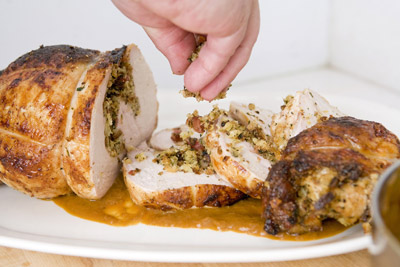
Ingredients
- 4 quarts water
- 1 cup packed light or dark brown sugar
- ¾ cup kosher salt, plus more for seasoning roulade
- 1 7-pound whole turkey breast, skin on, deboned
- 4 cups coarse fresh breadcrumbs (from a loaf of French or Italian bread)
- 8 ounces bacon, chopped and cooked until crisp, fat reserved (or substitute olive oil)
- 2 tablespoons unsalted butter, melted
- 2 tablespoons chopped garlic
- ½ cup chopped fresh parsley
- 1 teaspoon Emeril’s Original Essence or Creole Seasoning, plus more for seasoning roulade
- ¼ cup olive oil
- Freshly ground black pepper
- Peach and Sage Gravy (Click here for recipe.)
Directions
- Combine water, brown sugar, and salt in 2-gallon or larger stockpot, and whisk until sugar and salt have dissolved. Place turkey breast in stockpot and refrigerate for 8 hours.
- Remove turkey breast from brine, and pat dry with paper towels. (At this point you can proceed with recipe or refrigerate turkey up to 1 day until ready to cook.)
- Preheat oven to 350° F.
- Cut three lengths of kitchen twine to 32 inches, and lay across cutting board. Making sure skin is pulled down to cover as much of breast meat as possible, lay turkey breast, skin side down, on top of strings. Cover turkey with parchment paper or plastic wrap, and pound with heavy mallet or bottom of cast-iron skillet until thickest part of breast is no more than 2 inches thick.
- In large mixing bowl, use rubber spatula to combine breadcrumbs, bacon, ¼ cup reserved bacon fat, butter, garlic, parsley, and Original Essence or other seasoning.
- Lightly season turkey breast with Original Essence. Pack stuffing mixture tightly into 1-cup measure, and then empty stuffing onto middle of breast. Repeat two more times. Roll breast up as tightly as you can to form a cylinder, and use twine to tie breast together in three places. Snip off extra length of twine. (You can also tie twine vertically around breast, tucking in flaps at ends, if necessary to keep stuffing inside.) Brush olive oil all over roulade, and season lightly with Original Essence, kosher salt, and pepper.
- Heat large skillet or ovenproof roasting pan over medium-high heat. When hot, place turkey roulade into pan and sear until golden brown on all sides. Transfer pan to preheated oven and cook uncovered until center reaches an internal temperature of 155° to 160°F when tested with instant-read thermometer, 60 to 90 minutes. Remove turkey from oven and let rest for 20 minutes before carving.
- Remove strings and slice roulade crosswise into ½-inch-thick slices. Serve with Peach and Sage Gravy.
Peach and Sage Gravy
By Emeril Lagasse
Published October 17, 2012
(Makes about 3 cups)
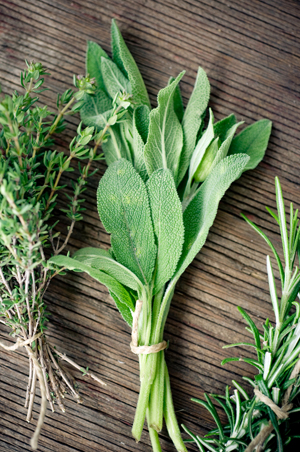
Ingredients
- 2 tablespoons olive oil
- ¼ cup finely minced shallots
- 2 teaspoons minced garlic
- ½ cup white wine vinegar
- 4 cups turkey stock, chicken stock, or canned low-sodium chicken broth
- ¾ cup peach preserves
- 2 tablespoons unsalted butter, at room temperature
- 2 tablespoons all-purpose flour
- ¼ teaspoon salt
- ¾ teaspoon freshly ground black pepper
- ⅟₃ cup fresh sage leaves
Directions
- Set 2-quart saucepan over medium heat and add olive oil. Once oil is hot, add shallots and garlic and sauté, stirring often, until shallots are fragrant and lightly caramelized, about 1 minute.
- Add white wine vinegar and cook until nearly completely reduced, about 1 minute.
- Add stock and preserves, and raise heat to high. While stock is coming to boil, combine butter and flour in small bowl and, using back of spoon, blend to form smooth paste.
- Add butter-flour paste to stock and use whisk to stir in, making sure it is well incorporated. Bring gravy to boil, season with salt and pepper, and reduce heat to simmer. Cook until gravy has reduced by one quarter, about 20 minutes.
- Remove pan from heat and add sage leaves to gravy. Allow flavors to steep for about 3 minutes, and then strain gravy. Serve gravy with slices of turkey roulade (click here for recipe).
Walnut Mushroom Pâté
Ingredients
- ½ cup chopped walnuts
- ¼ ounce dried porcini or wild mushrooms
- ⅓ cup hot tap water
- 8 ounce crimini mushrooms, stemmed and quartered
- 8 ounce white mushrooms, stemmed and quartered
- ½ cup coarsely chopped shallots
- 2 garlic cloves, coarsely chopped
- 1 tablespoon extra virgin olive oil
- 1 tablespoon dried thyme
- 2 teaspoons reduced-sodium soy sauce
- Salt and freshly ground black pepper
- 2 tablespoons chopped flat-leaf parsley, for garnish
Directions
- Preheat oven to 350°F.
- Spread walnuts on baking sheet. Stir and toast 5 minutes, until nuts are colored and fragrant. Transfer nuts to plate, cool and set aside.
- In small bowl, soak dried mushrooms in water until soft, 20–30 minutes. When soft, squeeze mushrooms until dry, catching liquid in small bowl. Strain liquid through paper coffee filter or fine strainer and set liquid aside. Coarsely chop soaked mushrooms and set aside.
- In food processor, combine half fresh mushrooms with shallots, garlic, and half soaked wild mushrooms. Pulse to chop very fine, 20 times; take care not to overprocess. In large skillet, heat oil over medium-high heat. Add chopped mushroom mixture, mixing to combine with oil. In food processor, finely chop remaining fresh and soaked mushrooms, then add to pan. (Do not clean out food processor.) Cook until mushrooms look wet, 8-10 minutes, stirring often. Add thyme, soy sauce, and reserved mushroom liquid. Continue cooking until mushrooms are golden and cling together, 8 minutes. Set aside.
- Add walnuts to food processor, and then cooked mushrooms. Pulse until mushroom-walnut mixture is nubbly; do not purée. Turn warm pâté into serving bowl and season to taste with salt and pepper. Or season pâté and cool to room temperature, cover tightly, and refrigerate for up to 5 days. Garnish with parsley and serve with toast points, crackers, or pita chips.
Nutrition Facts
Per Serving (1 tablespoon)
Calories: 25
Total fat: 2 g
Saturated fat: 0 g
Carbohydrate: 2 g
Fiber: 0 g
Protein: 1 g
Sodium: 10 mg
Carrot Top Pesto
By Anna Buss of Cookin’ the Market
Published June 28, 2013
(Serves 4–6)
Ingredients
- 1 bunch young carrots
- 1 cup arugula (optional)
- ¼ cup almonds in shell
- 1-2 teaspoons green garlic
- ½ cup olive oil
- Juice of ½ lemon
- Salt and pepper to taste
Directions
- Remove greens from carrots.
- Blanch greens in salted water until tender and bright green.
- Remove greens from water and shock in ice bath. Squeeze out water and set aside.
- Repeat steps 2 and 3 with arugula, and then with carrot bottoms.
- Blanch almonds until shells become loose. Remove almonds from water and allow to cool. Shell and set aside.
- Combine carrot greens, arugula, garlic, almonds, olive oil, and lemon in food processor. Blend until smooth, adding salt and pepper to taste.
- Toss pesto with blanched carrots, and serve. Pesto can also be tossed with your favorite spring salads, pasta, and veggies, or spread it on a sandwich.
Recipe created by Mario Hernandez, program coordinator and market chef for Cookin’ the Market
Christy’s Greens
By Elizabeth Murphy of West End Farmers Market/International Institute St. Louis
Published September 20, 2013

Serve Christy’s Greens over quinoa for a flavor-filled lunch.
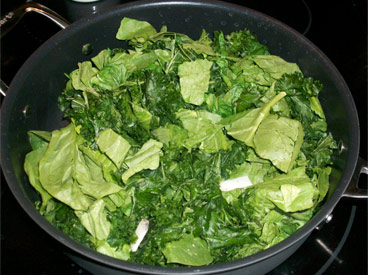

Ingredients
- 1 head mustard greens
- 2 cups kale
- 1 cup fresh spinach
- ½ head iceberg lettuce
- 1 turnip
- 4 medium cloves garlic
- 2 Tablespoons olive oil
- ½ teaspoon salt
- ½ teaspoon ground black pepper
Directions
- Remove hard stems from kale and mustard greens (leave stems if desired).
- Stack leaves on top of each other. Use knife to slice mustard greens, spinach, and kale into ¼-inch strips. Slice iceberg lettuce, but keep separate from other greens.
- In large bowl filled with cold water, add cut greens. Allow dirt to settle to bottom of bowl. Lift greens out of bowl. Shake off excess water. Repeat step with lettuce.
- Peel and mince garlic. Peel and slice turnip. Set aside.
- In a large skillet over medium-high heat, heat oil.
- Add mustard greens, spinach, and kale.
- Stir greens until wilted, about 1-2 minutes.
- Reduce heat to medium. Add garlic and turnip. Cook until greens are soft and excess water is gone, about 5-7 minutes. Add iceberg lettuce, cook for 1-2 minutes.
- Season with salt and pepper. Serve immediately.
Microbrew-Braised Rutabagas
By Post Editors
Published January 31, 2013
(Makes 6 servings as a side dish)

Ingredients
- 2 tablespoons unsalted butter
- 1 tablespoon extra-virgin olive oil
- 1 large yellow onion, about 12 ounces, thinly sliced
- 2 tablespoons firmly packed dark brown sugar
- 4 teaspoons kosher or fine sea salt
- ½ teaspoon ground Aleppo chile
- ¼ teaspoon freshly ground black pepper
- ¼ teaspoon ground cinnamon
- 2 pounds rutabagas, ends trimmed, peeled, and cut into ½-inch wedges
- One 12-ounce bottle porter-style beer
- 1½ cups canned low-sodium vegetable broth
- 2 teaspoons finely chopped fresh oregano
- 2 teaspoons finely chopped fresh thyme
Directions
- In Dutch oven or other heavy pot, melt butter with oil over medium-low heat until butter is foamy. Add onion and stir to coat evenly. Cover and cook until onion begins to soften, about 5 minutes. Uncover and continue to cook, stirring frequently, until onion is evenly golden brown and caramelized, about 20 minutes.
- Add brown sugar, salt, Aleppo pepper, black pepper, and cinnamon and stir constantly until brown sugar has melted and spices are aromatic, about 1 minute. Add rutabagas and stir to coat. Add beer and stock, pressing down on vegetables to submerge them. Liquid should just cover vegetables. If it doesn’t, add more stock or water as needed. Increase heat to medium-high and bring to a boil. Reduce heat until liquid is at a simmer, cover, and cook for 20 minutes. Stir in oregano and thyme, re-cover, and continue to cook until rutabagas are fork-tender, 5 to 10 minutes more. Using a slotted spoon, transfer rutabagas and onions to serving bowl, cover, and keep warm.
- Increase heat to high and boil braising liquid, stirring occasionally, until it reduces to about ¼ cup and has thickened to syrup consistency, 10 to 15 minutes. Reduce the heat to low, return rutabagas and onion to pan, and toss to coat in sauce. Heat until vegetables are hot, and then taste and adjust the seasoning. Serve immediately.
Deep Dish Cranberry Pie
By Post Editors
Published November 21, 2009

(Makes 8 to 10 servings)
Crust:
- 1 1/4 cup gluten-free flour
- 6 tablespoons unsalted butter, chilled and cut into small pieces
- 2 tablespoons vegetable shortening, chilled
- 1/4 teaspoon salt
- 4 tablespoons ice water, or more as needed
Place gluten-free flour and salt in medium bowl. Using pastry cutter or 2 knives, cut in butter and shortening until mixture resembles coarse crumbs. Add 2 tablespoons ice water, mix just until incorporated. Continue adding ice water as needed, 1 tablespoon at a time, until dough is smooth. Form dough into disk, wrap tightly with plastic wrap. Refrigerate 1 hour.
Preheat oven to 400 F. Remove dough from refrigerator, place on lightly gluten-free floured surface (we use an extra large Silpat-a sort of “rubber” nonstick mat, which really helps prevent dough from sticking to bottom surface). Lightly flour surface of dough with gluten-free flour. Roll pastry to large round, about 12 inches in diameter. Transfer to deep 9-inch pie plate, trim to within 1/2 inch of pan, crimp decoratively. If outer edges break off before folded under and crimped, just use excess dough. Press onto outer edge to form an even edge, then crimp. Prick with fork, cover. Refrigerate 20 to 30 minutes. Reserve any excess dough, reform into ball. Bake 15 to 30 minutes or until light brown. Remove form oven, let cool completely on wire rack.
Filling:
- 1 cup water
- 1 1/2 cups dried cherries
- 1 1/4 cups dried cranberries
- 1 (12 ounce) package fresh cranberries
- 1 1/4 cups granulated sugar
- 3 tablespoons gluten-free flour
- Zest of 1 lemon
- 1 tablespoon milk
- 1 tablespoon sugar
- 1 teaspoon cinnamon
In small saucepan, bring 1 cup water to simmer. Add dried cranberries and cherries. Remove from heat. Cover, let stand 20 minutes.
In large bowl, stir together fresh cranberries, undrained dried cherry-cranberry mixture, 1 1/4 cups sugar, gluten-free flour, and lemon zest. Pour mixture into prepared pie crust. Preheat oven to 375 F.
Roll out excess dough. Using small knife, cut out leaf shapes. Using tip of knife, vein leaves without cutting through dough. Using spatula, remove “leaves” and place on top of pie in decorative fashion. Using pastry brush, brush “leaves” with milk. Sprinkle top with sugar and cinnamon.
Cover pie edges with foil. Bake 45 to 50 minutes or until juices bubble and top of “leaves” are lightly browned. Transfer pie to cooling rack to cool.
Sauce:
- 1 cup crème fraîche
- 3 tablespoons wildflower honey
In medium bowl, whisk together crème fraîche and honey. To serve, place slice of pie on plate, drizzle sauce over top.
Recipe from Glutenfreeda Online Magazine and Recipe Book.
Norman Rockwell’s Oatmeal Cookies
By Corey Michael Dalton
Published December 29, 2011

Ingredients
- 1 stick butter
- 1 cup light brown sugar
- 1/2 cup granulated sugar
- 1 teaspoon vanilla
- 1/4 cup water and 2 eggs well beaten
- 1 teaspoon salt
- 1 cup flour, sifted
- 1/2 teaspoon baking soda
- About 1 cup oatmeal
- Chopped nuts (walnuts preferred)
Directions
Mix in order and drop on baking sheet. Bake 400° 7 to 8 minutes. Then run under broiler to brown.

